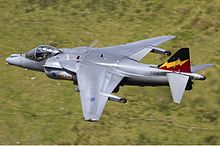No. 4 Squadron RAF
The more useful aircraft in its inventory were sent to France under the command of Major G. H. Rayleigh on 16 August 1914, to carry out reconnaissance in support of the British Expeditionary Force.
On 19 August Lieutenant G. W. Mapplebeck flew the squadron's first mission over France, a reconnaissance flight searching for German cavalry in the vicinity of Gembloux, Belgium.
[5][6][7] The contingent in France was reinforced on 20 September by the personnel who had remained behind in England, forming C Flight, equipped with Maurice Farman "Shorthorns".
In the Battle of the Somme, IV Squadron flew contact patrols keeping track of the position of advancing troops at low level, in addition to more regular reconnaissance and artillery spotting missions.
When the 1926 General Strike broke out, IV Squadron's aircraft were used to patrol railway lines to deter feared sabotage.
Following Germany's invasion of France and the Low Countries on 10 May 1940, IV Squadron was frequently forced to change bases by the approach of the advancing German armies, being withdrawn to the UK on 24 May.
[12] In 1942 the Squadron changed its mission from the Army co-operation role, where it would operate fairly low-performance aircraft from airstrips close to the front-line, to that of fighter-reconnaissance, receiving the more modern Curtiss Tomahawk and North American Mustang, with the latter soon replacing Tomahawk, flying low-level attack and reconnaissance flights against targets on the continent.
In August 1943, it joined 2 Tactical Air Force in support of the planned invasion of Europe, changing to the pure reconnaissance mission in January, and replacing its Mustangs with Mosquito PR.XVI and Spitfire PR.XIs.
It discarded its Mosquitoes in June, moved to France in August, and briefly supplemented its Spitfires with a few Hawker Typhoons for low-level reconnaissance.
It retained its Spitfires at VE Day, moving to Celle in Germany to carry out survey operations in support of the British Army of Occupation until it was disbanded on 31 August 1945.



